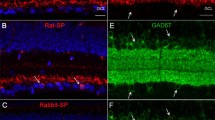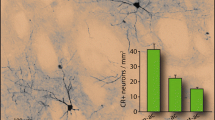Abstract
In this study, we examined the cellular distribution of encephalopsin (opsin 3; OPN3) expression in the striatum of non-human primates. In addition, because of our long standing interest in Parkinson’s disease and neuroprotection, we examined whether parkinsonian (MPTP; 1-methyl-4-phenyl-1,2,3,6-tetrahydropyridine) insult and/or photobiomodulation (670 nm) had any impact on encephalopsin expression in this key area of the basal ganglia. Striatal sections of control naïve monkeys, together with those that were either MPTP- and/or photobiomodulation-treated were processed for immunohistochemistry. Our results revealed two populations of striatal interneurones that expressed encephalopsin, one of which was the giant, choline acetyltransferase-containing, cholinergic interneurones. The other population had smaller somata and was not cholinergic. Neither cell group expressed the calcium-binding protein, parvalbumin. There was also rich encephalopsin expression in a set of terminals forming striosome-like patches across the striatum. Finally, we found that neither parkinsonian (MPTP) insult nor photobiomodulation had any effect on encephalopsin expression in the striatum. In summary, our results revealed an extensive network of encephalopsin containing structures throughout the striatum, indicating that external light is in a position to influence a range of striatal activities at both the interneurone and striosome level.


Similar content being viewed by others
Abbreviations
- ChAT:
-
Choline acetyltransferase
- DAB:
-
3,3′-Diaminobenzidine tetrahydrochloride
- Eno:
-
Encephalopsin
- GABA:
-
γ-aminobutyric acid
- MPTP:
-
1-methyl-4-phenyl-1,2,3,6-tetrahydropyridine
- OPN3:
-
Opsin 3
- PBM:
-
Photobiomodulation
- Pv:
-
Parvalbumin
- SNc:
-
Substantia nigra pars compacta
References
Bergman H, Deuschl G (2002) Pathophysiology of Parkinson’s disease: from clinical neurology to basic neuroscience and back. Mov Disord 17(Suppl 3):S28-40
Blackshaw S, Snyder SH (1999) Encephalopsin: a novel mammalian extraretinal opsin discretely localized in the brain. J Neurosci 19:3681–3690
Blandini F, Nappi G, Tassorelli C, Martignoni E (2000) Functional changes of the basal ganglia circuitry in Parkinson’s disease. Prog Neurobiol 62:63–88
Crittenden JR, Graybiel AM (2011) Basal ganglia disorders associated with imbalances in the striatal striosome and matrix compartments. Front Neuroanat 5. https://doi.org/10.3389/fnana.2011.00059
Darlot F, Moro C, El Massri N et al (2016) Near-infrared light is neuroprotective in a monkey model of Parkinson disease. Ann Neurol 79:59–75. https://doi.org/10.1002/ana.24542
El Massri N, Moro C, Torres N et al (2016) Near-infrared light treatment reduces astrogliosis in MPTP-treated monkeys. Exp Brain Res 1–8. https://doi.org/10.1007/s00221-016-4720-7
Flyktman A, Mänttäri S, Nissilä J et al (2015) Transcranial light affects plasma monoamine levels and expression of brain encephalopsin in the mouse. J Exp Biol 218:1521–1526. https://doi.org/10.1242/jeb.11186
Gonzales KK, Smith Y (2015) Striatal Cholinergic interneurons in the dorsal and ventral striatum: anatomical and functional considerations in normal and diseased conditions. Ann N Y Acad Sci 1349:1–45. https://doi.org/10.1111/nyas.12762
Hamblin MR (2016) Shining light on the head: Photobiomodulation for brain disorders. BBA Clin 6:113–124. https://doi.org/10.1016/j.bbacli.2016.09.002
Jankovic J, Poewe W (2012) Therapies in Parkinson’s disease. Curr Opin Neurol 25:433–447. https://doi.org/10.1097/WCO.0b013e3283542fc2
Johnstone DM, Moro C, Stone J et al (2016) Turning on lights to stop neurodegeneration: the potential of near infrared light therapy in Alzheimer’s and Parkinson’s disease. Front Neurosci 9:500. https://doi.org/10.3389/fnins.2015.00500
Kawaguchi Y, Wilson CJ, Augood SJ, Emson PC (1995) Striatal interneurones: chemical, physiological and morphological characterization. Trends Neurosci 18:527–535. https://doi.org/10.1016/0166-2236(95)98374-8
Mitrofanis J (2017) Why and how does light therapy offer neuroprotection in Parkinson’s disease? Neural Regen Res 12:574–575
Nissilä J, Mänttäri S, Särkioja T et al (2012) Encephalopsin (OPN3) protein abundance in the adult mouse brain. J Comp Physiol A Neuroethol Sens Neural Behav Physiol 198:833–839. https://doi.org/10.1007/s00359-012-0754-x
Nisslia J, Manttari S, Tuominen H et al (2011) The abundance and distribution of encephalopsin (OPN3) protein in human brain
Parent A, Hazrati L-N (1995) Functional anatomy of the basal ganglia. I. The cortico-basal ganglia-thalamo-cortical loop. Brain Res Rev 20:91–127. https://doi.org/10.1016/0165-0173(94)00007-C
Shaw VE, Spana S, Ashkan K et al (2010) Neuroprotection of midbrain dopaminergic cells in MPTP-treated mice after near-infrared light treatment. J Comp Neurol 518:25–40. https://doi.org/10.1002/cne.22207
Terakita A (2005) The opsins. Genome Biol 6:213. https://doi.org/10.1186/gb-2005-6-3-213
Acknowledgements
We are forever grateful to Michael J Fox Foundation, Credit Agricole Sud Rhones Alpes, Fondation Philanthropique Edmond J Safra, France Parkinson and the French National Research Agency (ANR Carnot Institute), Tenix corp and Salteri family and our industry partners for funding this work. We thank Sharon Spana, Diane Agay, Fannie Darlot, Claude Chabrol, Guillaume Barboux, Clément Perrin, Cyril Zenga and Mylène D’Orchymont for excellent technical assistance. All authors contributed to the experiments and analysis of the results and NEM and JM to the writing of the manuscript.
Author information
Authors and Affiliations
Corresponding author
Ethics declarations
Conflicts of interest
The authors delares that there is no conflicts of interests to declare.
Rights and permissions
About this article
Cite this article
El Massri, N., Cullen, K.M., Stefani, S. et al. Evidence for encephalopsin immunoreactivity in interneurones and striosomes of the monkey striatum. Exp Brain Res 236, 955–961 (2018). https://doi.org/10.1007/s00221-018-5191-9
Received:
Accepted:
Published:
Issue Date:
DOI: https://doi.org/10.1007/s00221-018-5191-9




